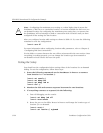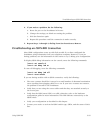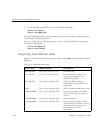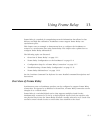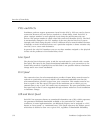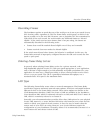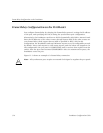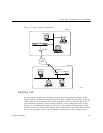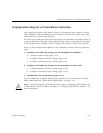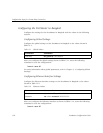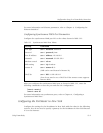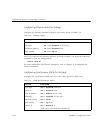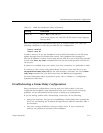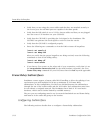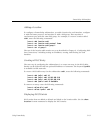
Frame Relay Configuration on the PortMaster
13-6 PortMaster Configuration Guide
Note – Contact your Frame Relay carrier to determine which keepalive they are using,
LMI or Annex-D.
To enable LMI, use the following command:
Command> set W1 lmi Seconds
Enabling Annex-D
The PortMaster also accepts the Annex-D polling interval. The Annex-D default value is
10 seconds. However, if your telephone company chooses another keepalive value,
change this value as they instruct you. Enabling LMI causes the DLCI list to be
completed automatically. Setting the keepalive value to 0 (zero) seconds, or enabling
LMI, disables Annex-D.
Note – Contact your Frame Relay carrier to determine which keepalive they are using,
LMI or Annex-D.
To enable Annex-D, use the following command:
Command> set W1 annex-d Seconds
Listing DLCIs for Frame Relay Access
If LMI or Annex-D is not used, you must enter the DLCI list manually. The DLCI list is
a list of DLCIs that are accessible through the Frame Relay network by this interface.
The PortMaster uses Inverse ARP to learn the IP addresses of routers attached to the
PVCs represented by the specified DLCIs, if those routers support Inverse ARP.
Alternatively, you can specify IP addresses by appending a colon (:) and IP address after
the DLCI.
The DLCI list can be provided by your Frame Relay carrier. For dynamically learned lists,
32 PVCs are allowed. Only 16 PVCs can be specified if the DLCI and IP address are
entered. If you specify only DLCIs, you can list 24. When the PVC and IP address are
specified, the PortMaster statically configures these entries into its ARP table.
To enter the DLCI list manually, use the following command:
Command> set W1 dlci Dlci_list
For information on Frame Relay subinterfaces see “Frame Relay Subinterfaces” on page
13-12.
✍
✍



